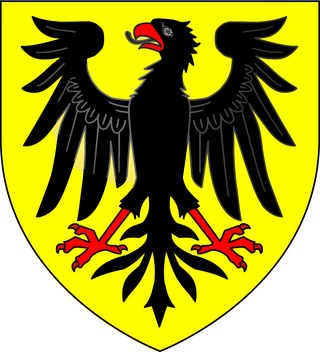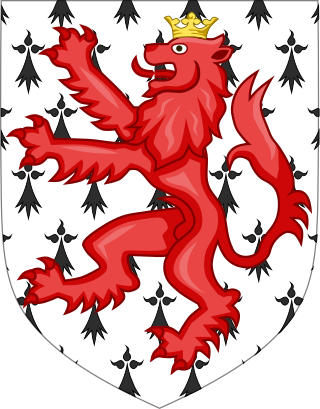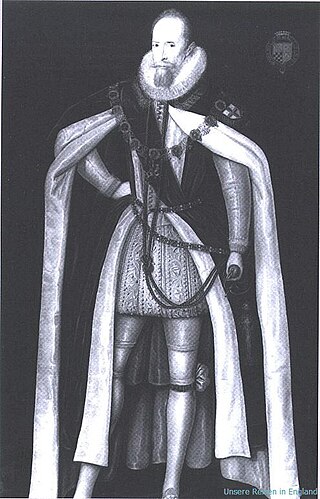
Earl of Suffolk is a title which has been created four times in the Peerage of England. The first creation, in tandem with the creation of the title of Earl of Norfolk, came before 1069 in favour of Ralph the Staller; but the title was forfeited by his heir, Ralph de Guader, in 1074. The second creation came in 1337 in favour of Robert de Ufford; the title became extinct on the death of his son, the second Earl, in 1382. The third creation came in 1385 in favour of Michael de la Pole. The fourth creation was in 1603 for Lord Thomas Howard, the second son of Thomas Howard, 4th Duke of Norfolk, by his second wife Margaret Audley, the daughter and eventual sole heiress of Thomas Audley, 1st Baron Audley of Walden, of Audley End in the parish of Saffron Walden in Essex. Howard was a prominent naval commander and politician and served as Earl Marshal, as Lord Chamberlain of the Household and as Lord High Treasurer. In 1597 he was summoned to Parliament as Baron Howard de Walden, and in 1603 he was further honoured, at the start of the reign of King James I, when he was created Earl of Suffolk. His second son the Hon. Thomas Howard was created Earl of Berkshire in 1626.

Henry Cary, 1st Viscount Falkland, KB, PC was an English landowner and politician who sat in the House of Commons from 1601 to 1622. He was created Viscount Falkland in the Scottish peerage in 1620. He was Lord Deputy of Ireland from 1622 until 1629.

Edward Seymour, 1st Earl of Hertford, 1st Baron Beauchamp, KG, of Wulfhall and Totnam Lodge in Great Bedwyn, Wiltshire, of Hatch Beauchamp in Somerset, of Netley Abbey, Hampshire, and of Hertford House, Cannon Row in Westminster, is most noted for incurring the displeasure of Queen Elizabeth I by taking part in more than one clandestine marriage.

William Howard, 1st Viscount Stafford, FRS was the youngest son of Thomas Howard, 21st Earl of Arundel, and his wife, the former Alethea Talbot. A Fellow of the Royal Society from 1665, he was a Royalist supporter before being falsely implicated by Titus Oates in the later discredited "Popish Plot", and executed for treason. He was beatified as a Catholic martyr by Pope Pius XI in 1929.

Sir Thomas Temple, 1st Baronet was an English landowner and Member of Parliament.

Edward Cecil, 1st Viscount Wimbledon was an English military commander and a politician who sat in the House of Commons at various times between 1601 and 1624.

Bindon Abbey (Bindonium) was a Cistercian monastery, of which only ruins remain, on the River Frome about half a mile east of Wool in the Purbeck District, Dorset, England.
Events from the 1550s in England. This decade marks the beginning of the Elizabethan era.
Sir Thomas Penyston, 1st Baronet (1591–1644) was a 17th-century member of the gentry who received one of the first baronetcies. In 1637 he was sheriff of Oxfordshire and in 1640, he was a member of parliament for Westbury.

Sir Heneage Finch was an English lawyer, Member of Parliament, and politician who sat in the House of Commons at various times between 1607 and 1626. He was Speaker of the English House of Commons in 1626.

Woolbridge Manor is a 17th-century manor house just outside the village of Wool, in Dorset, England. English Heritage have designated it a Grade II* listed building. It is on the north side of the old Wool bridge, a historic crossing point over the River Frome, now closed to traffic except pedestrians and cyclists due to a bypass and junction.

Robert Sackville, 2nd Earl of Dorset (1561–1609) was an English aristocrat and politician, with humanist and commercial interests.

James Turberville was an English cleric who served as Bishop of Exeter from 1555 to 1559.
The manor of Agney was an estate in Old Romney, Kent owned by the Dean and Chapter of Canterbury Cathedral. The estate may have originated in the eighth century and for hundreds of years was leased to members of the same family, including Sarah, Duchess of Marlborough. It is frequently referred to as Agney Court, Agne Court, Agnes Court or even Aghne Court.

Thomas Howard, 1st Viscount Howard of Bindon, was an English peer and politician. He was the youngest son of Thomas Howard, 3rd Duke of Norfolk and Lady Elizabeth Stafford. He served as Custos Rotulorum of Dorset and Vice-Admiral of Dorset. In 1559, he was raised to the peerage as Viscount Howard of Bindon by Queen Elizabeth I of England, taking the title from Bindon Abbey in Dorset, many of whose former lands he held. Thomas had eight children by three wives.
John Villiers was an English courtier from the Villiers family. The eldest son of Sir George Villiers and Mary Beaumont, later Countess of Buckingham, he was the brother of King James I's favourite, George Villiers, 1st Duke of Buckingham.
Elizabeth Howard, Lady Knollys, was a courtier to Anne of Denmark.

John Strode, the son of Robert Strode of Parnham, Dorset and Elizabeth Hody, was elected MP for Dorset in 1572 and was Sheriff of Dorset from 1572 to 1573.

Susanna Temple, Lady Lister was an English courtier.














